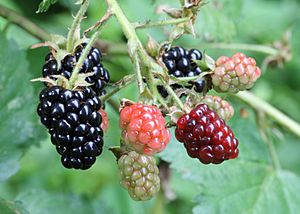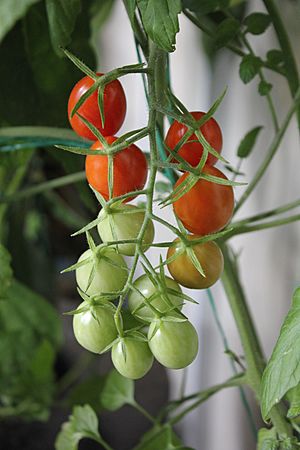Ripening facts for kids

Ripening is a natural process where a fruit becomes ready to eat. It gets softer, sweeter, and often changes color. Some fruits, like tomatoes or mangoes, keep ripening even after they are picked. This means they can be picked when they are still a bit firm and will continue to get ripe at home. Other fruits, such as cherries or figs, stop ripening once they are picked. So, they need to be fully ripe when you buy them.
Contents
What Happens During Ripening?
Fruits that continue to ripen after being picked are called climacteric fruits. During ripening, many changes happen inside the fruit. It becomes softer, sweeter, and less bitter. Its color also changes.
These changes usually start in the inner part of the fruit, near the seeds. Once the seeds are ready, the ripening process spreads outwards. As the fruit ripens, you can see it getting softer and changing color. This process also starts the production of a gas called ethylene, which helps the fruit ripen even more.
Why Do Colors Change?
The color changes you see are because of pigments. Pigments are natural colors inside the fruit. When a fruit is unripe, it often looks green because of a pigment called chlorophyll. As the fruit ripens, the chlorophyll breaks down and disappears. This allows other colors, like red, yellow, or orange, to become visible. The fruit also makes new pigments as it ripens, making its colors even brighter.
Why Do Fruits Get Softer?
The walls of fruit cells are mostly made of a substance called pectin. During ripening, special enzymes (natural chemicals that speed up reactions) change the pectin. They turn it from a firm, water-insoluble form into a softer, water-soluble form. This process breaks down the fruit's structure, making it less firm and easier to chew.
How Do Fruits Get Sweeter?
Unripe fruits often contain a lot of starch, which is a type of carbohydrate. As the fruit ripens, enzymes break down these large starch molecules into smaller, sweeter sugars like fructose, glucose, and sucrose. This is why ripe fruit tastes much sweeter than unripe fruit.
Also, acids inside the fruit break down during ripening. This makes the fruit taste less tart or sour and more sweet. For example, in some fruits like guava, the amount of vitamin C (which is an acid) goes down as the fruit ripens.
Tomato Ripening Stages
Different fruits have different stages of ripening. For tomatoes, here are the main stages:
- Green: The whole surface of the tomato is green.
- Breaker: Less than 10% of the tomato's surface has turned red or pink.
- Turning: Between 10% and 30% of the surface is red or pink.
- Pink: Between 30% and 60% of the surface is red or pink.
- Light Red: Between 60% and 90% of the surface is red.
- Red: Almost the entire surface of the tomato is red.
Images for kids
-
A bunch of Cabernet Sauvignon wine grapes at different levels of ripeness.
-
Lemons turn yellow as they ripen.
-
Honeycrisp apples
See also
 In Spanish: Maduración (alimento) para niños
In Spanish: Maduración (alimento) para niños





